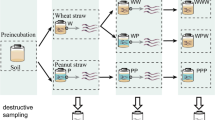Summary
Soil samples obtained from various forested sites in North Carolina and Washington and from Alaskan tundra were examined for the presence of heterotrophic, nonsymbiotic nitrogen-fixing micro-organisms.
Aerobic, nitrogen-fixing micro-organisms were not isolated from any of the soils examined.
Estimates of anaerobic nitrogen-fixing bacteria in these soils ranged from 50,000 to 2,000,000/g when a dilution plate technique and a medium supplemented with potato extract was used. However, the isolation of individual colonies from the dilution plates showed that many of these bacteria were unable to fix nitrogen. Soil populations well below 100,000/g were generally indicated by this colony isolation technique. Differentiation of the colonies by size improved the accuracy of the dilution plate estimates somewhat. Dilution tube procedures appeared more suitable for obtaining accurate counts of nitrogen-fixing anaerobes in the soil than the use of dilution plates.
The predominant nitrogen-fixing bacterium in most soils was a facultative anaerobe,Bacillus polymyxa. Appreciable numbers of nitrogen-fixing clostridia were also found in several tree nursery soils but were seldom isolated from forest and tundra samples.
The clostridia isolated were classified asClostridium butyricum andC. pasteurianum. Variations in the fermentation patterns of these bacteria occurred when the nitrogen supply of the medium was altered. TheC. butyricum isolates were all from forest soils while all except one of theC. pasteuranium isolates were from tundra soils.
Similar content being viewed by others
Literature cited
Alexander, M., Most-probable-number method for microbial population, p. 1467–1472.In W. V. Bartholomew and F. E. Clark (ed.). Soil Nitrogen, Amer. Soc. Agron., Madison (1965).
Boswell, J. G., The microbiology of acid soils. 4. Selected sites in Northern England and Southern Scotland. New Phytol.54, 311–319 (1955).
Bredemann, G., Untersuchungen über die Variation und das Stickstoffbindungsvermogen desBacillus asterosporus A.M., Ausgefuhrt an 27 Stammen verschiedener Herkunft. Zentralbl. Bakteriol. Abt. 2,22, 44–89 (1908).
Brown, M. E., Burlingham, S. K. and Jackson, R. M., Studies on Azotobacter species in soil. 1. Comparison of media and techniques for counting azotobacter in soil. Plant and Soil17, 309–319 (1962).
Chang, P. C. and Knowles, R., Nonsymbiotic nitrogen fixation in some Quebec soils. Can. J. Microbiol.11, 29–38 (1965).
Dorner, W., Beobachtungen über das Verhalten der Sporen und vegetativen Formen vonBacillus amylobacter A.M. et Bredemann bei Nachweis und Reinzucht-versuchen. Lands. Jahrb. Schweiz.38, 175–202 (1924).
Dubber, H. J., Untersuchungen zur N2-Bindung bei der Verrottung von Waldgraserwurzen unter microaeroben Bedingungen. Plant and Soil23, 247–256 (1965).
Emtsev, V. T., Sources of carbon nutrients for nitrogen-fixing bacteria of the genusClostridium. Microbiology (English transl. Mikrobiologiya)31, 13–17 (1962).
Emtsev, V. T., Quantitative estimation of anaerobic nitrogen-fixing butyric acid bacteria belonging to the genusClostridium in the soil. Microbiology (English transl. Mikrobiologiya)31, 237–241 (1962).
Feher, D., Untersuchungen über die Mikrobiologie des Waldbodens. Julius Springer Co., Berlin. 272 pp. (1933).
Feher, D. and Frank, M., Untersuchungen über den periodischen Kreislauf des Stickstoffe, des Phosphors und des Kaliums im dem Waldboden. Z. Pflanzenernähr. Dung. Boden43, 5–33 (1936).
Foerster, H. F. and Foster, J. W., Response ofBacillus spores to combinations of germinative compounds. J. Bacteriol.91, 1168–1177 (1966).
Hart, G. R. H., A study of sporeforming bacteria from soil. Unpubl. Ph.D. Thesis, Univ. London. 125 pp. (1955).
Jackson, A. W. and Henry, A. W., Occurrence ofBacillus polymyxa (Praz.) Mig in Alberta soils with special reference to its pathogenicity on potato tubers. Can. J. Research C24, 39–46 (1946).
Jensen, V., Activity of various physiological groups of microorganisms in some forest soils. Royal Vet. Agr. Coll. Yearb. Copenhagen. 1962. 180–194 (1962).
Jensen, V., Studies on the microflora of Danish beech forest soils. 3. Properties and composition of the bacterial flora. Zentralbl. Bakteriol. Abt. 2116, 593–611 (1963).
Jensen, V. and Petersen, E. J., Studies on the occurrence of azotobacter in Danish forest soils. Kgl. Vet. Landbok. Arss.1954, 95–108 (1954).
Krassilnikov, N. A., Diagnostik der Bakterien und Actinomyceten. Gustav Fischer Publ., Jena. 813 pp. (1959).
Lambina, V. A., Distribution of soil bacteria fermenting plant protopectin in fields under grassland crop rotation. Microbiology (English transl. Mikrobiologiya)26, 71–78 (1956).
Little, E. L., Jr. Check list of native and naturalized trees of the United States (including Alaska). U.S. Dept. of Agr. Handbook41, 472 pp. (1953).
Loub, W., Untersuchungen zur mikrobiologie Afrikanischer Boden. Bodenkultur14, 189–208 (1963).
Meiklejohn, Jane, Microbiology of the nitrogen cycle in some Ghana soils. Empire J. Exp. Agr.30, 115–126 (1962).
Menna, M. E. di, The incidence ofAzotobacter and of nitrogen-fixing clostridia in some New Zealand soils. New Zealand J. Agr. Research9, 218–226 (1966).
Moore, A. W., Non-symbiotic nitrogen fixation in soil and soil-plant systems. Soils Fert.29, 113–129 (1966).
Parker, C. A., Nonsymbiotic nitrogen-fixing bacteria in soil 1. Studies onClostridium butyricum. Australian J. Agr. Research5, 90–97 (1954).
Parker, C. A., Anaerobiosis with iron wool. Australian J. Exp. Biol.33, 33–38 (1955).
Prevot, A., Manual for the Classification and Determination of the Anaerobic Bacteria. Lea and Febiger, Philadelphia (1966).
Ross, D. J., Influence of media on the counts ofClostridium butyricum in soils. Nature181, 1142–1143 (1958).
Smith, N. R., Gordon, R. E. and Clark, F. E., Aerobic sporeforming bacteria. U.S. Dept. Agr. Mono.16, 148 pp. (1952).
Stout, J. D., A bacterial survey of some New Zealand forest lands, grasslands, and peats. New Zealand J. Agr. Research4, 1–30 (1961).
Swaby, R. J., The occurrence and activities ofAzotobacter andClostridium butyricum in Victorian soils. Aust. J. Exp. Biol. Med. Sci.18, 401–423 (1939).
Author information
Authors and Affiliations
Additional information
Paper number2998 of the Journal Series of the North Carolina State University Agricultural Experiment Station, Raleigh, N.C
Rights and permissions
About this article
Cite this article
Jurgensen, M.F., Davey, C.B. Nonsymbiotic nitrogen-fixing micro-organisms in forest and tundra soils. Plant Soil 34, 341–356 (1971). https://doi.org/10.1007/BF01372789
Received:
Issue Date:
DOI: https://doi.org/10.1007/BF01372789




